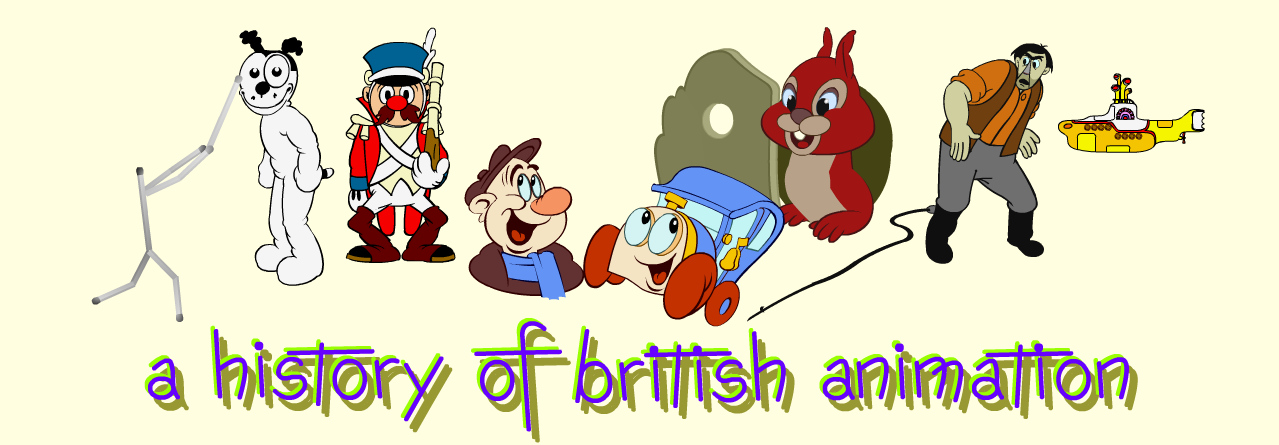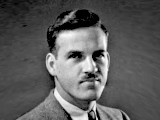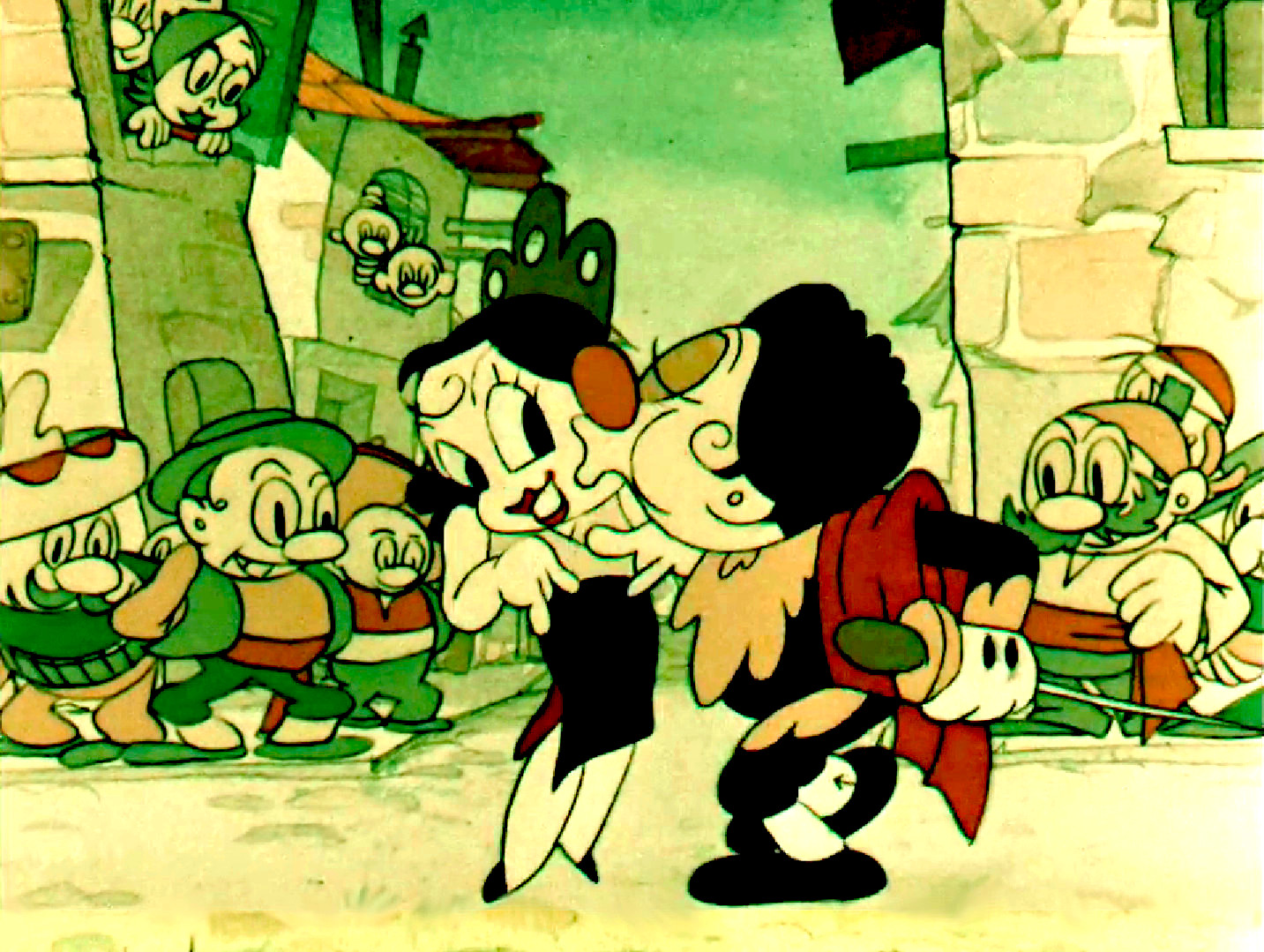

|
 | Henning Dahl Mikkelsen(1915-1982) |  |
||
|
Henning Dahl Mikkelsen was born on January 9, 1915 in Skive, Denmark, son of the owner of the city's leading hardware store. His talent for drawing was recognised at school and when left at 16, in 1931, he was apprenticed to a local artwork company. When the family moved to Struer, home of the Bang and Olufsen factory, the young Mikkelsen designed the iconic logo for them that is still used today. But Mikkelsen wanted to be a cartoonist, especially for animated films, and when in 1932 he read an article about Jørgen Myller and his new Copenhagen cartoon studio he sent them some samples of his artwork. Myller hired him, and later commented that from the very beginning he proved to be a sort of genius for making cartoons. Myller's studio was making advertising cartoons, but the ultimate goal of Myller and his scriptwiter and Inbetweener Anker Roepstorff was to make entertainment shorts, and they were greatly influenced by the American cartoons, particularly those of Hugh Harman and Rudolph Ising, who had left Disney's in 1927, when Charles Mintz took over Oswald the Lucky Rabbit and subsequently created the Bosko series for Leon Schlesinger's Looney Tunes. The Danish studio's first entertainment cartoon, Et bankkup (A Bank Robbery) released in February 1934, featured a black-and-white character who was virtually Bosko's double. Bosko was meant to be an African American youth, but his design was basically Mickey Mouse without the ears – a standard black and white cartoon character. Myller's character was called Columbus and in the film he is a policeman, chasing the bank robber Sugar Foot Bill by riding a cow on roller skates. Jazz musicians Erik Kragh and Leo Mathiesen supplied the music and the voices, and the film was made in English for international sales. It made a loss, however, and finance for the proposed series could not be secured. While the fim was in production Anker Roepstorff had scripted his idea for a short cartoon burlesque of Carmen. Myller thought that as a Danish studio they should make a version of a Hans Christian Andersen story, and selected The Tinder Box. Character models (and possibly layouts) for this were drawn up, but there was no money for either project to go into full production and the studio concentrated on its advertising work. Later in 1934 Myller left Copenhagen for London, and a few days later Roepstorff and Mikkelsen received a letter telling them that he was now working for a new cartoon studio, British Utility Films, with animator Sid Griffiths, and urging them to close the Copenhagen studio and come and join him. The three Danes worked on advertising films for British Utility Films until 1935, when wealthy producer Archibald Nettleford set up a new studio, Anglia Films to be headed by veteran animator Anson Dyer. Dyer had continued to make films using cutout animation, but the new company was to make fully animated cel cartoons, in colour, both for advertising and entertainment films, and Griffiths and the Danes were recruited to provide the animation. The colour system to be used was the two-colour Dunningcolor process. The studio was situated in Jermyn Street, in the well-to-do St James's area of London. Dyer now took the roll of producer, with Griffiths directing and the Danes providing the design and animation. The Danes presented Dyer with the script for Carmen and Dyer agreed to put it into production. However, the subsequent idea of basing a cartoon on Stanley Holloway's comic monologue Old Sam (aka Pick Oop Tha' Musket) seemed more likely to be a success, and took priority when it came to releasing the films. Sam and his Musket premiered at ther Rialto, Coventry Street, on 8 November 1935, with the second in the proposed Sam Small series already in production, and Carmen was finally released along with this film, 'Alt! 'Oo Goes Theer? in April 1936. Four more Sam Small cartoons followed – Sam's Medal, Beat the Retreat, Drummed Out and Three Ha'pence a Foot (Sam's charge for timber when Noah builds his Ark in Yorkshire!) – as well as the first of a planned series based on Holloway's other famous monologue, The Lion and Albert, and the studio was also making advertising films for various clients. When they closed Myller's Copenhagen studio Mikkelsen had arranged for the completion of a commercial they were making for the advertising agency Monterossi, and he continued to make films for them as well, animating them in London and sending the drawings to the agency's studio where former Myller trainee Bjørn Frank Jensen traced and painted them and assisted in the shooting. Mikkelsen returned to Copenhagen from time to time to check on progress and pick up new assignments. Despite their popularity Anson Dyer's entertainment films were not making a profit, and Nettlefold's accountants advised him to cut his losses. The Danes were getting homesick, and Mikkelsen returned to Denmark in 1937 to concentrate on newspaper cartoons, including his long-running and widely syndicated Ferd'nand comic strip, which he had developed while in London with help from Anker Roepstorff. His cartoons carried the shortened signature Mik. Myller returned from London and formed a cartoon studio for Gutenberghus Reklame Film, an advertising film company, and Mikkelsen joined him. The studio was subsequently taken over by the German company Vepro, and Anker Roepstorff rejoined them as Scriptwriter and Inbetweener. Henning Dahl Mikkelsen married Gretha Marie Johansen in 1939. They had a daughter, but the marriage was later dissolved. The Danish branch of Vepro closed down in the autumn of 1942. Mikkelsen and Myller kept the studio running as Mik & Myller Film for a short while. But Myller decided to quit animation and concentrate instead on magazine illustration. In 1943 Gutenberghus Reklame Film hired commercial film director Jens Henriksen to head a new studio, hiring some cartoonists to complete animation based on key drawings by Mikkelsen, who continued to freelance as a draftsman, illustrator, animator and cartoon director. Besides Ferd'nand he drew comic strips written by other authors, such as The Hansen Family and Lise and Lasse. In 1944 he animated a black-and-white cartoon sequence for Palladium Film's live-action feature The Gelinde Family, and a cartoon short, also in black-and-white, Ferd'nand's Fishing Trip, featuring his comic strip character, with a script by Anker Roepstorff. In the absence of American cartoons due to the German Occupation, this film was well received and was followed by a second, Ferd'nand's Bear Hunt, in 1945. This film was released a few months after Denmark was liberated, and fared badly against the influx of American technicolor cartoons. While no further Ferd'nand entertainment films followed, the Swedish chocolate manufacturer Cloëtta Mjölkchoklad commissioned four short colour advertising films featuring the character. These were produced by Swedish animation studio Sago-Konst, from key drawings sent to Stockholm by Mikkelsen. Mikkelsen had long dreamed of working for Disney, and in August 1946 he left Copenhagen for a three-week visit to California. He did not meet Walt himself, and the people he spoke to at Disney were more interested in hiring him as a storyman. Disappointed, he tried Hanna and Barbera's unit at MGM, but with no success. he returned to Copenhagen, and his Ferd'nand strip, which was becoming internationally popular. He had not been deterred, however, and he emigrated to California in 1948, becoming a United States citizen in 1954. In October 1949 he married Jessie Andersen, and they raised three daughters and a son. Mikkelsen continued to focus on Ferd'nand, the success of which required a regular stream of new ideas, which Mikkelsen found tiresome. He relied on several people to supply him with ideas for a fee, particularly Roepstorff back in Copenhagen. According to Don Markstein's Toonopedia a comic book artist called Frank Thomas (not the Disney animator), who had been assisting him, ghosted the strip between the late 1950s and early 1960s, and Al Plastino took it over in 1968. Henning Dahl Mikkelsen died of a heart attack on June 2, 1982, aged 67.
|
Filmography | ||||
| title | (studio, date) credit | |||
| title | (studio, date) credit | |||
| title | (studio, date) credit | |||
| title | (studio, date) credit | |||
| title | (studio, date) credit | |||
Links to Other Sites | ||||
|
Dansk Tegnefilms Historie Danish Cartoons 1930–1942 English language page about Danish animators of the 1930s, ending with biographical information on Henning Dahl "Mik" Mikkelsen. |
Peter Hale
Last updated 2022
|